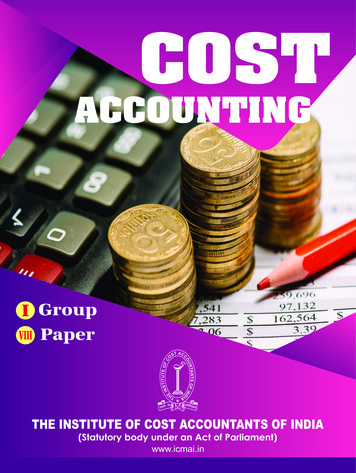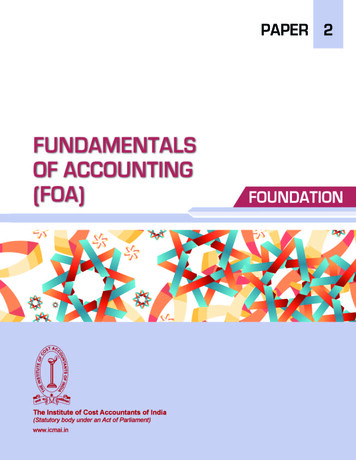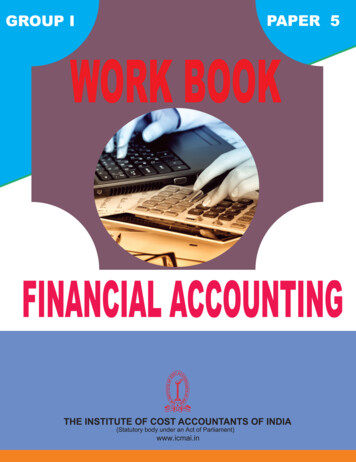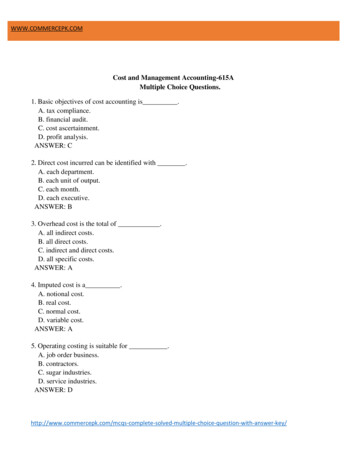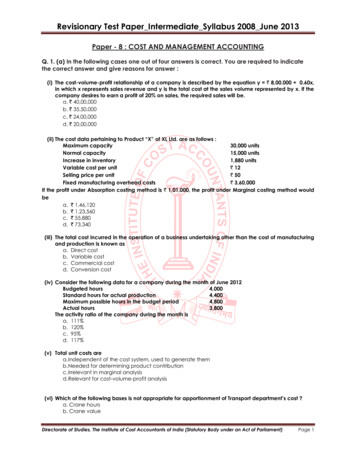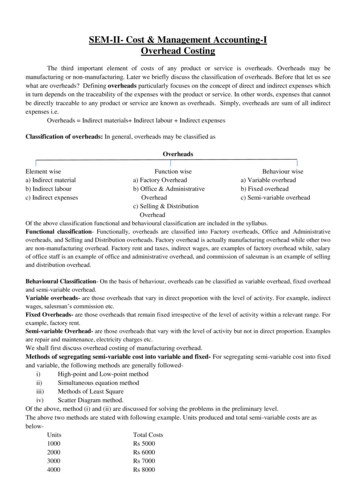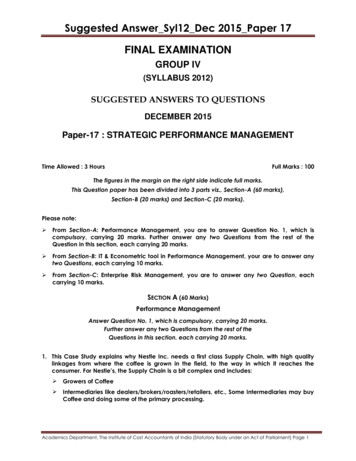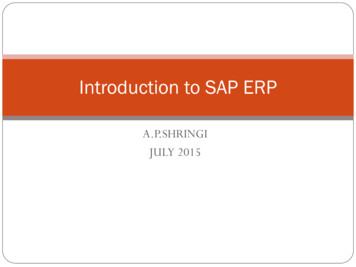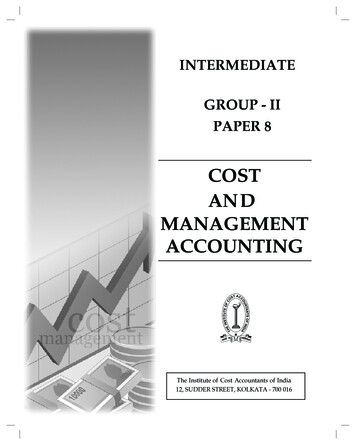
Transcription
INTERMEDIATEGROUP - IIPAPER 8COSTANDD DMANAGEMENTACCOUNTINGThe Institute of Cost Accountants of India12, SU DDER STREET, KOLKATA - 700 016
Repro India LimitedPlot No. 50/2, T.T.C. MIDC Industrial Area,Mahape, Navi Mumbai 400 709, India.Website: www.reproindialtd.com
CONTENTSPage No.Study Note 1Financial Accounting, Cost Accounting and Management Accounting1 - 22Study Note 2Material Control23-48Study Note 3Labor Cost Computation and Control49-88Study Note 4Overheads89-118Study Note 5Methods of Costing-Job Batch and Contract Costing119-146Study Note 6Process Costing147-180Study Note 7Joint Product and By-products181-196Study Note 8Inter-Locking Accounts Cost Control Accounts197-210Study Note 9Integrated Accounting System211-230
Page No.Study Note 10Reconciliation of cost and financial Accounts231-246Study Note 11Operating Costing247-258Study Note 12Marginal Costing and Break even Analysis259-304Study Note 13Budgets and Budgetary Control305-348Study Note 14Standard Costing349-396Study Note 15Uniform Costing and Inter Firm Comparison397-406Study Note 16Activity Based Costing407-416Study Note 17Transfer Pricing417-428Sets of Objective Questions Cost and Management Accounting429-440Appendix One - Formulae441-447
ountingSTUDY NOTE 1Learning ObjectivesAfter studying this topic, you should be able to,1.Understand the concept of Financial Accounting,Cost Accounting and Management Accounting.2.Understand role of Financial Accounting, CostAccounting and Management Accounting.3.Understand the various concepts in the three types ofAccounting Systems.4.Understand the difference between the three systemsof Accounting.
Financial Accounting, Cost Accounting and Management Accounting1.1 IntroductionAccounting is a very old science which aims at keeping records of various transactions. The accounting isconsidered to be essential for keeping records of all receipts and payments as well as that of the incomeand expenditures. Accounting can be broadly divided into three categories.Financial Accounting, aims at finding out profit or losses of an accounting year as well as the assets andliabilities position, by recording various transactions in a systematic manner.Cost Accounting helps the business to ascertain the cost of production/services offered by the organizationand also provides valuable information for taking various decisions and also for cost control and costreduction.Management Accounting helps the management to conduct the business in a more efficient manner.The scope of management accounting is broader than that of cost accounting. In other words, it can besaid that the management accounting can be considered as an extension of cost accounting. ManagementAccounting utilises the principles and practices of financial accounting and cost accounting in additionto other modern management techniques for efficient operation of a company. The main thrust inmanagement accounting is towards determining policy and formulating plans to achieve desiredobjectives of management. Management Accounting makes corporate planning and strategies effectiveand meaningful.In the present chapter all these concepts are discussed in detail in order to make the concepts more clear.1.2 Financial AccountingFinancial Accounting aims at finding the results of an accounting year in terms of profits or losses andassets and liabilities. In order to do this, it is essential to record various transactions in a systematicmanner. Financial Accounting is defined as, ‘Art and science of classifying, analyzing and recordingbusiness transactions in a systematic manner in order to prepare a summary at the end of the year to findout the results of the concerned accounting year.’ The definition given above is self explanatory, howeverfor understanding clearly, the following terms are explained below.ABusiness transactions :- A transaction means an activity, a business transaction means any activitywhich creates some kind of legal relationship. For example, purchase and sale of goods, appointingan employee and paying his salary, payment of various expenses, purchase of assets etc.BClassification of transactions :- Before recording any transaction, it is essential that it is to be classified.A transaction can be classified as cash transaction and credit transaction. Similarly transactionsof receiving income and payment of expenditure can be segregated. Even in case of expenditure,transactions involving revenue expenditure and capital expenditure can be segregated.CRecording of transactions :- The essence of financial accounting is recording of transaction. Inaccounting language, recording of the transaction is known as entry. There are well defined rulesfor recording various transactions in books of accounts. As per the rules of financial accounting,each and every transaction is recorded at two places and hence it is called as ‘Double Entry’ systemof accounting.2
Cost and Management AccountingDSummary of transactions :- After recording all transactions, it is essential to prepare a summary ofthem so as to draw meaningful conclusions. The summary will help in finding out the Profit/Lossof a particular year and also ascertaining Assets and Liabilities on a particular date. In fact, the verypurpose of financial accounting is to know the results of a particular year. From this angle, the processof preparing the summary is extremely important.1.2.1Concepts and conventions of Financial Accounting :- There are some well defined concepts andconventions of financial accounting system. Concepts can also be termed as ‘principles’ whileconventions are those which have been followed over a period of time and are accepted asnorms to be followed in financial accounting systems. The concepts and conventions of financialaccounting are explained in the following paragraphs.1.2.2Concepts of Financial Accounting:- The following are the concepts of financial accounting.A. Separate Entity :- This concept implies that the businessman is different from business. Thusif X starts his business known as X and Sons, X as a person shall be different from his firm,i.e. X and Sons. Actually in Law, separate entity concept is recognized only in the case ofjoint stock companies registered under Companies Act, 1956. In case of partnerships and soleproprietorship business, separate entity concept is not recognized under Law. However inaccounting, separate entity concept is recognized and the accounting entries are passed inthe books of the business and not in the books of the proprietor as such. Thus when X startshis business and invests his own money as capital, it is shown as liability in the Balance Sheetof the business. On the other hand, if the proprietor incurs any private expenditure from theresources of the business, it is shown as recoverable in the books of accounts of the business.Thus the principle of separate entity is applied in practice.B. Double Entry :- This principle can be called as ‘Heart’ of the entire accounting mechanism.Double entry means a transaction is recorded at two places in the books of accounts, thereason being that any transaction has two fold effects and hence it is to be recorded at twoplaces. The following example will clarify the point.1.If goods are purchased for cash, the cash goes out and goods come in. Thus one effect isthe cash going out and the second effect is that goods come in.2.When goods are sold for cash, the first effect is that the cash comes in and the second oneis that the goods are going out.3.In case of credit transactions like purchase of goods, one effect is that goods come in andthe person from whom the goods are purchased becomes the creditor of the business.Thus in double entry system, each and every transaction has the two fold effects. There isanother system of recording the transactions, which is known as single entry system. In singleentry system, every transaction is recorded only once and hence no double effect is given.There are very few organizations where single entry system is still implemented. Howeverthe double entry system is now being accepted everywhere.C. Money Measurement Concept :- Another important concept of financial accounting is themoney measurement concept. This concept means that only the transactions which arecapable of being expressed in monetary terms will be recorded in the books of accounts. Inother words, transactions which cannot be expressed in monetary terms cannot be recorded3
Financial Accounting, Cost Accounting and Management Accountingin the books of accounts. For example, in books of accounts monetary value of assets or goodswill be recorded and not the quantity of the same. Furniture will not be recorded as 1 tableor 12 chairs or 100 cupboards, but the values of the same in monetary terms will be recorded.This principle means that items like Human Resources will not be recorded in the books ofaccounts as they cannot be converted into monetary terms. This principle is important as itbrings uniformity in recording transactions in the books of accounts.D. Going Concern Concept :- As per Glossary of terms, International Accounting Standards,1999, the definition of ‘Going Concern’ is as follows‘That enterprise is normally viewed as a going concern, that is as continuing in operationfor the foreseeable future. It is assumed that the enterprise has neither the intention nor thenecessity of liquidation or curtailing materially the scale of its operations.’The implications of this concept is that the financial statements, fixed assets are shown at thecost of acquisition less depreciation accumulated up to the date of closure. The reason is that it isassumed that the enterprise is going to continue for a long period of time and there is no intentionto close it down in the near future. Therefore the market values of the same are not relevant at all,the cost prices are relevant and hence the assets should be shown at the cost value.E.Matching Concept :- Matching of costs and revenues concept is explained below in theInternational Accounting Standards‘Expenses are recognized in the income statement on the basis of a direct association betweenthe costs incurred and the earnings of specific items of income. This process involves thesimultaneous or combined recognition of revenues and expenses that result directly andjointly from the same association or other events. However, the application of the matchingconcept does not allow the recognition of items in the Balance Sheet which do not meet thedefinition of assets or liabilities.’In other words, matching concept means that it is necessary to periodically match the costsand revenues in order to find out the results of a particular period. This period is called asaccounting year. For any business it is essential to find out the profit or loss after periodicintervals. Actually, real profit or loss can be found out only after the business is closed down.But in the earlier concept we have seen that any business organization is a going concern andnot likely to shut down in the near future. Therefore it is necessary to match the revenue andexpenditure on periodic basis. This period is normally for one year and is called as accountingyear. In case of limited companies established under the Companies Act, 1956, first accountingyear in case of a company can be of 18 months but subsequent accounting years must be of 12months duration. A business organization is free to choose the accounting year, i.e. a calendaryear can be adopted as accounting year or financial year starting from 1st April to 31st Marchcan be an accounting year. The assessment year for income tax purpose is always from 1st Aprilto 31st March and hence many organizations adopt this period as accounting year.1.2.3Accounting Cycle : It is essential to describe the accounting cycle in brief. The cycle commenceswith the happening of a transaction and ends with the preparation of final accounts, i.e. Profit and LossAccount and Balance Sheet. The following chart will show the accounting cycle.4
Cost and Management AccountingTransaction Entry Books of Prime Entry – Journal and Subsidiary Books Posting in Ledger – Book of Secondary Entry Trial Balance Final Accounts – Profit and Loss Account and Balance SheetAs mentioned above, the accounting cycle starts with a transaction. As soon as a transaction takes place, itis recorded in the books of Prime Entry, i.e. either Journal or subsidiary books. After recording the same inthese books, the transaction is posted in the ledger which is called as book of secondary entry. All ledgeraccounts are closed and a list of the same is prepared which is called as ‘Trial Balance’. From the trialbalance, final accounts, Profit and Loss Account and Balance Sheet are prepared.1.2.4Utility of Financial Accounting : The utility of financial accounting can be explained in thefollowing manner.A. Financial Accounting provides well defined rules and principles of recording business transactions.This provides uniformity in recording the transactions and thus results of various organizationsbecome comparable.B.For any organization, whether it is profit making or non-profit making, it is essential to find outthe results of a particular accounting period, i.e. accounting year. Financial accounting mechanismenables them to prepare Profit and Loss Account and Balance Sheet at the end of the financial year.C. Financial Accounting helps the taxation authorities for determining the tax liability in a fair manner.Income Tax is levied on the profits and financial accounting helps to disclose true and fair view of thebusiness as regards to profits. Thus the assessment of tax liability becomes rational and free from anycontroversies.D. Financial Accounting is also helpful for the investors who are interested in finding out the profitabilityof the business in which they want to invest the money. Financial accounting information helps inascertaining profitability so that decision-making is easier.E.In the course of the business, a firm has to borrow money for various objectives such as expansion,diversification, modernization and so on. The lenders have to ensure that the money lent by themwill be repaid back. For this, they study financial statements viz. Profit and Loss Account and BalanceSheet to ascertain the financial condition of the business. Thus the financial accounting helps them indecision-making regarding granting of loan.5
Financial Accounting, Cost Accounting and Management AccountingF.Financial accounting also provides useful information for the purpose of valuation of business duringmerger and acquisition process.1.3 Cost AccountingAs compared to the financial accounting, the focus of cost accounting is different. In the modern days ofcut throat competition, any business organization has to pay attention towards their cost of production.Computation of cost on scientific basis and thereafter cost control and cost reduction has become ofparamount importance. Hence it has become essential to study the basic principles and concepts of costaccounting. These are discussed in the subsequent paragraphs.1.3.1Cost :- Cost can be defined as the expenditure (actual or notional) incurred on or attributableto a given thing. It can also be described as the resources that have been sacrificed or must besacrificed to attain a particular objective. In other words, cost is the amount of resources used forsomething which must be measured in terms of money. For example – Cost of preparing one cupof tea is the amount incurred on the elements like material, labor and other expenses, similarlycost of offering any services like banking is the amount of expenditure for offering that service.Thus cost of production or cost of service can be calculated by ascertaining the resources used forthe production or services.1.3.2Costing :- Costing may be defined as ‘the technique and process of ascertaining costs’. Accordingto Wheldon, ‘Costing is classifying, recording, allocation and appropriation of expenses forthe determination of cost of products or services and for the presentation of suitably arrangeddata for the purpose of control and guidance of management. It includes the ascertainment ofevery order, job, contract, process, service units as may be appropriate. It deals with the cost ofproduction, selling and distribution.If we analyze the above definitions, it will be understood that costing is basically the procedureof ascertaining the costs. As mentioned above, for any business organization, ascertaining of costsis must and for this purpose a scientific procedure should be followed. ‘Costing’ is precisely thisprocedure which helps them to find out the costs of products or services.1.3.3Cost Accounting :- Cost Accounting primarily deals with collection, analysis of relevant of costdata for interpretation and presentation for various problems of management. Cost accountingaccounts for the cost of products, service or an operation. It is defined as, ‘the establishment ofbudgets, standard costs and actual costs of operations, processes, activities or products and theanalysis of variances, profitability or the social use of funds’.1.3.4Cost Accountancy :- Cost Accountancy is a broader term and is defined as, ‘the application ofcosting and cost accounting principles, methods and techniques to the science and art and practiceof cost control and the ascertainment of profitability as well as presentation of information for thepurpose of managerial decision making.’If we analyze the above definition, the following points will emerge,A. Cost accounting is basically application of the costing and cost accounting principles.B.6This application is with specific purpose and that is for the purpose of cost control, ascertainmentof profitability and also for presentation of information to facilitate decision making.
Cost and Management AccountingC. Cost accounting is a combination of art and science, it is a science as it has well defined rulesand regulations, it is an art as application of any science requires art and it is a practice as ithas to be applied on continuous basis and is not a one time exercise.1.3.51.3.6Objectives of Cost Accounting :- Objectives of Cost Accounting can be summarized as under1.To ascertain the cost of production on per unit basis, for example, cost per kg, cost per meter,cost per liter, cost per ton etc.2.Cost accounting helps in the determination of selling price. Cost accounting enables todetermine the cost of production on a scientific basis and it helps to fix the selling price.3.Cost accounting helps in cost control and cost reduction.4.Ascertainment of division wise, activity wise and unit wise profitability becomes possiblethrough cost accounting.5.Cost accounting also helps in locating wastages, inefficiencies and other loopholes in theproduction processes/services offered.6.Cost accounting helps in presentation of relevant data to the management which helps indecision making. Decision making is one of the important functions of Management and itrequires presentation of relevant data. Cost accounting enables presentation of relevant datain a systematic manner so that decision making becomes possible.7.Cost accounting also helps in estimation of costs for the future.Essentials of a good Costing system :- For availing of maximum benefits, a good costing systemshould possess the following characteristics.A. Costing system adopted in any organization should be suitable to its nature and size of thebusiness and its information needs.B.A costing system should be such that it is economical and the benefits derived from the sameshould be more than the cost of operating of the same.C. Costing system should be simple to operate and understand. Unnecessary complicationsshould be avoided.D. Costing system should ensure proper system of accounting for material, labor andoverheads and there should be proper classification made at the time of recording of thetransaction itself.1.3.7E.Before designing a costing system, need and objectives of the system should be identified.F.The costing system should ensure that the final aim of ascertaining of cost as accuratelypossible should be achieved.Certain Important Terms :- It is necessary to understand certain important terms used in costaccounting.A. Cost Center :- Cost Center is defined as, ‘a production or service, function, activity or itemof equipment whose costs may be attributed to cost units. A cost center is the smallest7
Financial Accounting, Cost Accounting and Management Accountingorganizational sub unit for which separate cost allocation is attempted’. To put in simplewords, a cost center is nothing but a location, person or item of equipment for which costmay be ascertained and used for the purpose of cost control. For example, a productiondepartment, stores department, sales department can be cost centers. Similarly, an item ofequipment like a lathe, fork-lift, truck or delivery vehicle can be cost center, a person likesales manager can be a cost center. The main object of identifying a cost center is to facilitatecollection of costs so that further accounting will be easy. A cost center can be either personalor impersonal, similarly it can be a production cost center or service cost center. A cost centerin which a specific process or a continuous sequence of operations is carried out is known asProcess Cost Center.B. Profit Center :- Profit Center is defined as, ‘a segment of the business entity by which bothrevenues are received and expenses are incurred or controlled’. (CEMA) A profit center isany sub unit of an organization to which both revenues and costs are assigned. As explainedabove, cost center is an activity to which only costs are assigned but a profit center is onewhere costs and revenues are assigned so that profit can be ascertained. Such revenuesand expenditure are being used to evaluae segmental performance as well as managerialperformance. A division of an organization may be called as profit center. The performanceof profit center is evaluated in terms of the fact whether the center has achieved its budgetedprofits. Thus the profit center concept is used for evaluation of performance.1.3.8Costing Systems :- There are different costing systems used in practice. These are describedbelow.A. Historical Costing :- In this system, costs are ascertained only after they are incurred and thatis why it is called as historical costing system. For example, costs incurred in the month ofApril, 2007 may be ascertained and collected in the month of May. Such type of costing systemis extremely useful for conducting post-mortem examination of costs, i.e. analysis of the costsincurred in the past. Historical costing system may not be useful from cost control point ofview but it certainly indicates a trend in the behavior of costs and is useful for estimation ofcosts in future.B. Absorption Costing :- In this type of costing system, costs are absorbed in the product unitsirrespective of their nature. In other words, all fixed and variable costs are absorbed in theproducts. It is based on the principle that costs should be charged or absorbed to whatever isbeing costed, whether it is a cost unit, cost center.C. Marginal Costing :- In Marginal Costing, only variable costs are charged to the products andfixed costs are written off to the Costing Profit and Loss A/c. The principle followed in thiscase is that since fixed costs are largely period costs, they should not enter into the productionunits. Naturally, the fixed costs will not enter into the inventories and they will be valued atmarginal costs only.D. Uniform Costing :- This is not a distinct method of costing but is the adoption of identicalcosting principles and procedures by several units of the same industry or by severalundertakings by mutual agreement. Uniform costing facilitates valid comparisons betweenorganizations and helps in eliminating inefficiencies.8
Cost and Management Accounting1.3.9Classification of Costs :- An important step in computation and analysis of cost is theclassification of costs into different types. Classification helps in better control of the costs andalso helps considerably in decision making. Classification of costs can be made according to thefollowing basis.A. Classification according to elements :- Costs can be classified according to the elements. Thereare three elements of costing, viz. material, labor and expenses. Total cost of production/services can be divided into the three elements to find out the contribution of each element inthe total costs.B. Classification according to nature :- As per this classification, costs can be classified intoDirect and Indirect. Direct costs are the costs which are identifiable with the product unitor cost center while indirect costs are not identifiable with the product unit or cost centerand hence they are to be allocated, apportioned and then absorb in the production units. Allelements of costs like material, labor and expenses can be classified into direct and indirect.They are mentioned below.i.Direct and Indirect Material :- Direct material is the material which is identifiable withthe product. For example, in a cup of tea, quantity of milk consumed can be identified,quantity of glass in a glass bottle can be identified and so these will be direct materialsfor these products. Indirect material cannot be identified with the product, for examplelubricants, fuel, oil, cotton wastes etc cannot be identified with a given unit of productand hence these are the examples of indirect materials.ii.Direct and Indirect Labor :- Direct labor can be identified with a given unit of product,for example, when wages are paid according to the piece rate, wages per unit can beidentified. Similarly wages paid to workers who are directly engaged in the productioncan also be identified and hence they are direct wages. On the other hand, wages paid toworkers like sweepers, gardeners, maintenance workers etc are indirect wages as theycannot be identified with the given unit of production.iii. Direct and Indirect Expenses :- Direct expenses refers to expenses that are specificallyincurred and charged for specific or particular job, process, service, cost center or costunit. These expenses are also called as chargeable expenses. Examples of these expensesare cost of drawing, design and layout, royalties payable on use of patents, copyrightsetc, consultation fees paid to architects, surveyors etc. Indirect expenses on the otherhand cannot be traced to specific product, job, process, service or cost center or costunit. Several examples of indirect expenses can be given like insurance, electricity, rent,salaries, advertising etc.It should be noted that the total of direct expenses is known as ‘Prime Cost’ while the total ofall indirect expenses is known as ‘Overheads’.C. Classification according to behavior :- Costs can also be classified according to their behavior.This classification is explained below.i.Fixed Costs :- Out of the total costs, some costs remain fixed irrespective of changes inthe production volume. These costs are called as fixed costs. The feature of these costs isthat the total costs remain same while per unit fixed cost is always variable. Examples ofthese costs are salaries, insurance, rent, etc.9
Financial Accounting, Cost Accounting and Management Accountingii.Variable Costs :- These costs are variable in nature, i.e. they change according to thevolume of production. Their variability is in the same proportion to the production. Forexample, if the production units are 2,000 and the variable cost is Rs. 5 per unit, the totalvariable cost will be Rs. 10,000, if the production units are increased to 5,000 units, thetotal variable costs will be Rs. 25,000, i.e. the increase is exactly in the same proportionof the production. Another feature of the variable cost is that per unit variable costremains same while the total variable costs will vary. In the example given above, theper unit variable cost remains Rs. 2 per unit while total variable costs change. Examplesof variable costs are direct materials, direct labor etc.iii. Semi-variable Costs :- Certain costs are partly fixed and partly variable. In other words,they contain the features of both types of costs. These costs are neither totally fixed nortotally variable. Maintenance costs, supervisory costs etc are examples of semi-variablecosts. These costs are also called as ‘stepped costs’.D. Classification according to functions :- Costs can also be classified according to the functions/activities. This classification can be done as mentioned below.i.Production Costs :- All costs incurred for production of goods are known as productioncosts.ii.Administrative Costs :- Costs incurred for administration are known as administrativecosts. Examples of these costs are office salaries, printing and stationery, office telephone,office rent, office insurance etc.iii. Selling and Distribution Costs :- All costs incurred for procuring an order are called asselling costs while all costs incurred for execution of order are distribution costs. Marketresearch expenses, advertising, sales staff salary, sales promotion expenses are some ofthe examples of selling costs. Transportation expenses incurred on sales, warehouse rentetc are examples of distribution costs.iv. Research and Development Costs :- In the modern days, research and development hasbecome one of the important functions of a business organization. Expenditure incurredfor this function can be classified as Research and Development Costs.E.10Classification according to time :- Costs can also be classified according to time. Thisclassification is explained below.I.Historical Costs :- These are the costs which are incurred in the past, i.e. in the past year,past month or even in the last week or yesterday. The historical costs are ascertainedafter the period is over. In other words it becomes a post-mortem analysis of what hashappened in the past. Though historical costs have
Management Accounting utilises the principles and practices of fi nancial accounting and cost accounting in addition to other modern management techniques for effi cient operation of a company. The main thrust in management accounting is towards determining policy and formulating plans to a

